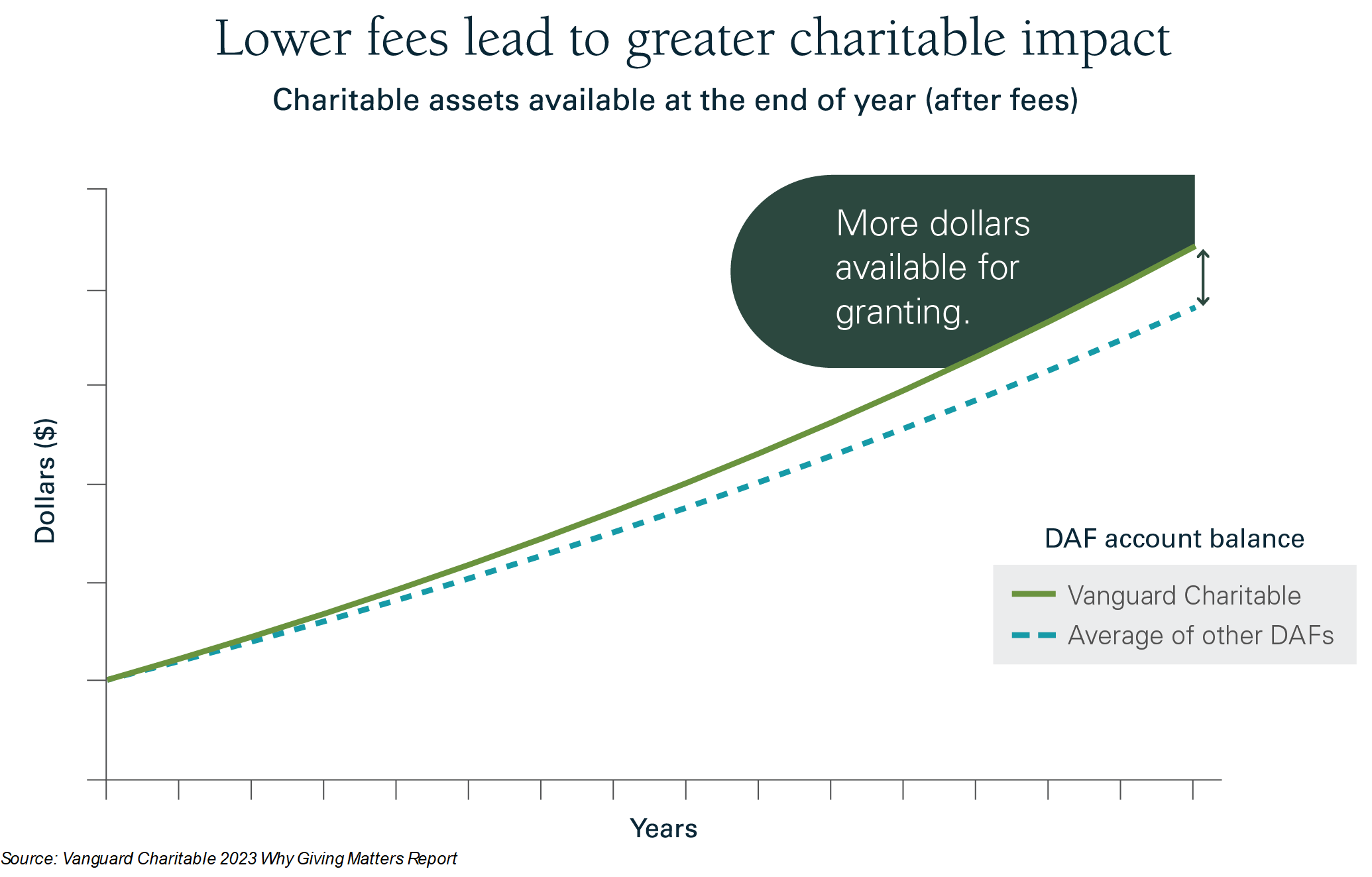
Charitable giving vehicles can be powerful tools in maximizing philanthropic impact. Private foundations, charitable trusts and donor-advised funds (DAFs) all allow donors to invest charitable assets for growth, expand the assets they can give to charity, and help with due diligence around selecting causes and organizations to support. This kind of strategic support requires oversight and administration — both of which carry a cost.
Many factors influence your ability to earn a return. That’s true across all kinds of investing, including charitable investing, where "return" equates to "charitable impact" for the causes philanthropically minded investors care about. While we can't control markets or the economy, we can control the costs we pay in managing or allocating our charitable dollars.
Ultimately, investment data is clear: The expense ratio is the most proven predictor of future fund returns. Money paid in fees ultimately comes out of the sum of assets, which means there is less to invest, grow and use for grantmaking.
Understanding the nature of fees and costs and their impact on an individual’s ability to give is an essential component of an effective charitable giving strategy. That strategy starts with a deeper dive into the fees and how they differ across giving vehicles. When evaluating costs and fees in philanthropic giving, particularly in the context of private foundations and donor-advised funds (DAFs), here are a few key points to keep in mind.
Most charitable giving costs fall into two categories
Most of the costs associated with investing — whether it be for charitable giving, retirement or other purposes — come from one of two sources: investment fees and administrative fees.
Investment fees cover the costs of managing invested assets. Different asset classes will have different fees and overall costs, and different investment vehicles and advisers will as well.
Administrative fees cover general operating costs, including legal, accounting, processing and staffing expenses. These administrative fees can also vary greatly depending on the organization or individual overseeing the philanthropic strategy. Costs related to operations, and tools such as investor services, investment portals and research, may be included under administrative fees.
Different approaches come with different costs
The complexity and focus of the charitable investment vehicle can be a driving force in cost structure and overall fees. A private foundation can include services and approaches highly tailored to a family or donor’s specific needs. Naturally, those high-touch services can increase administrative fees. At the same time, advisers and other oversight or guidance can also drive up investment fees.
DAFs, a giving vehicle that can support a wide array of causes through grants to qualified 501(c)(3) charities, tend to prioritize a low-cost, high-impact approach to philanthropy. DAFs benefit from economies of scale around operations and grantmaking, with annual administrative fees among national DAF sponsors typically falling around 0.6%, and investment fees ranging from 0.015% to 0.99%. Community foundations may charge more for DAFs but may also offer useful philanthropic and granting guidance relevant to the communities they serve.
Certain DAF sponsors, including Vanguard Charitable, utilize additional levers to maintain low costs. These can include curating a smaller number of high-performing investment options, as well as giving donors access to low-cost share classes typically unavailable to the public.
There’s also a broader philosophical perspective around fees and costs worth exploring across giving vehicles. Some organizations align their entire approach around keeping costs low. At Vanguard Charitable, for instance, recent reductions in the expense ratios for several of its 35 investment options will lead to annual savings of more than $1 million, which will be granted by Vanguard Charitable donors to hardworking charities across the country and the world.
Savings — and tax benefits — compound over time

Investors like to call compound growth “the eighth wonder of the world.” And for good reason. Just like saving for retirement or any other investment approach, the positive effect of lower fees has a greater impact over time. These compound benefits play out on a few key fronts. Lower investment and administrative fees mean a greater portion of assets can be directed toward charitable investments. This, in turn, means more dollars are available to grant to nonprofits, deliver on a philanthropic strategy, and make an impact on meaningful cause areas.
The compound benefits extend to tax savings, too. The upfront tax savings for charitable contributions means more dollars are available to potentially grow and grant out over time. At the same time, the tax-free earnings for assets in an account compound over time, again allowing more money to be directed toward charitable giving. These tax savings can be achieved with both DAFs and private foundations, although private foundations are subject to a separate excise tax on net investment income, whereas DAFs are not.
Meaningful conversations around costs and charitable giving
Strategic charitable giving can seem complex. At the end of the day, the approach to costs is simple: Lower fees mean more money can be made available for the charities you care about.
Considerations around costs and fees are vital for charitable giving planning. Individuals and families looking to extend their philanthropic mission should explore these details, seeking out partners who are transparent about their fee structures and committed to keeping costs low. Ultimately, that commitment will allow donors to do more with their charitable dollars to continue supporting the causes that matter most to them — now and well into the future.







